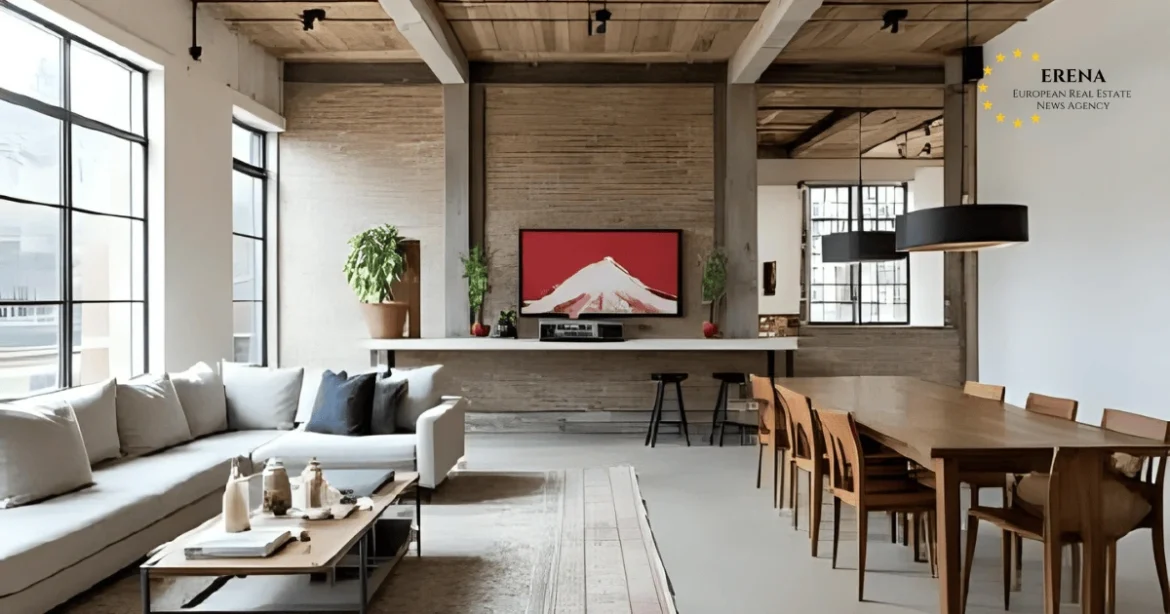When New York artists in the 1970s began moving into abandoned factories, few could imagine that exposed pipes, rough concrete and brick walls would one day define one of the world’s most desirable interior styles. Half a century later, the industrial look is no longer a niche for loft dwellers — in 2025 it’s just as likely to appear in a 35-square-meter Warsaw studio as in a Scandinavian villa overlooking the sea. The question is no longer whether industrial belongs in homes, but how to make it both stylish and comfortable.
From Cold Warehouses to Warm Living Rooms
Industrial style is often associated with harshness: gray walls, steel beams, concrete floors. But today’s designers stress that this image is outdated.
“Retrofit is really about attitude. It’s not about copying factory spaces — it’s about re-using what exists, giving materials a second life, and creating interiors that feel authentic.” — Je Ahn, Studio Weave
That “attitude” explains why concrete floors are now paired with reclaimed oak, or why black steel frames are softened with linen curtains. Industrial 2025 is about contrasts — cold and warm, raw and cozy, past and present.
Apartments: Loft Spirit in Small Spaces
For years many believed industrial only works in vast lofts. Yet designers across Europe prove otherwise. In Kraków, a young couple recently renovated a 42 m² flat with just one bold brick wall and a steel-frame partition.
“We couldn’t afford a big loft, but we wanted that atmosphere. Just one wall changed the mood of the entire apartment,” the owners explain.
Costs remain accessible compared to luxury finishes: brick slips start from around €25 per square meter, slimline steel partitions average €200 per square meter, and a track lighting kit (€300) is often enough to bring a loft-like atmosphere even to a compact flat.
Houses: Industrial Drama on a Larger Scale
Private houses allow the style to unfold in full scale. Designers like Patricia Urquiola often emphasize that industrial must not feel cold or inhuman.
“Design today must be hybrid and flexible, able to adapt to changing contexts.” — Patricia Urquiola
Her approach shows why raw concrete and steel can coexist with textiles, greenery, and color — transforming roughness into warmth. Polished concrete floors cost €40–60/m² if an existing slab is polished, but up to €170/m² for a new pour. Large glazed walls or Crittall-style steel windows easily exceed €1,000 per unit, yet homeowners increasingly see such investments as essential for architectural character.
How to Avoid the “Cold Warehouse” Effect
The risk of overdoing it is real. Too much exposed concrete or metal can feel sterile. The antidote is warmth — textiles, natural wood, soft lighting, plants. Rugs, boucle armchairs, and linen curtains are now staples. Many homeowners mix industrial bones with Scandinavian or vintage touches, creating more welcoming hybrids.
Why It’s Booming in 2025
Industrial resonates with today’s values: authenticity, sustainability, flexibility. Designers increasingly use reclaimed materials — aged wood, recycled steel, salvaged brick — turning ecological awareness into an aesthetic principle. Chrome and brass accents, showcased at Paris Design Week 2025, add a modern reflective twist.
“Design should be simple and honest.” — Philippe Starck
This philosophy explains why the industrial look, once considered too raw, has become a global design language.
Practical Guide with 2025 Prices
Polished concrete flooring remains a classic. If the slab already exists, polishing costs €40–60 per m². A new poured finish is more expensive — from €140 to €170 per m² — but it will last for decades.
A brick accent wall instantly adds character. Basic brick slips start from €25 per m², while handmade or reclaimed bricks can exceed €150 per m².
Glass partitions in Crittall style are popular for zoning. They let light through and add a graphic edge. Expect around €200 per m², with doors starting from €950.
Lighting defines mood. Track lights cost €300–600 per set, while designer pendants start from €700. Many combine both: track lights for functionality and a bold pendant for atmosphere.
To add warmth, choose wood. Engineered boards cost €60–90 per m², while solid planks start at €100. Add textiles — a rug, throw, curtains. Even a small €100–150 investment creates coziness.
Finally, plants. A ficus or monstera (€30–80) can bring life to even the most austere concrete interior.
Conclusion
Industrial style is no longer about living in a warehouse. In 2025 it is about stories told through materials: the patina of steel, the scars of reclaimed wood, the softness of fabrics against raw walls. It is bold yet humane, functional yet warm. With the right balance, industrial design transforms apartments and houses into spaces that feel authentic, sustainable, and full of character.

